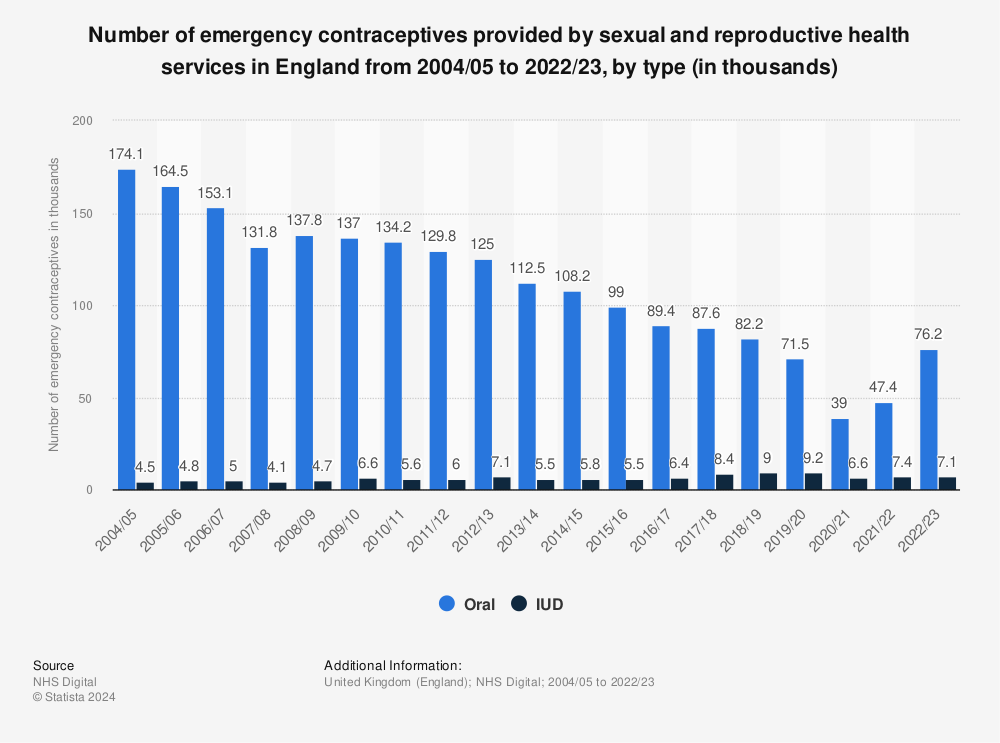-
NHS
-
Oldham Services
-
Shop
-
Help & Advice
Although it’s rarely talked about openly, emergency contraception is more widely used than many might think. Despite being an urgent option for preventing pregnancy after unprotected sex or contraceptive failure, for many, the topic can feel uncomfortable or sensitive, leading to a hesitancy to discuss it openly. This silence often surrounds the use of emergency contraception with a sense of secrecy or embarrassment.
At Click2Pharmacy, we want to encourage open discussions about sensitive topics, particularly sexual health. We’ve explored the latest statistics and trends around emergency contraception use in England for 2023 to shed light on the reality of emergency contraception use in the UK.
To find this data, we collected emergency contraception statistics from multiple sources. This includes NHS statistics on Sexual and Reproductive Health and OpenPrescribing. We also used other reliable sources to ensure our data was accurate and up-to-date, which are mentioned throughout our findings.
Emergency contraception is a method of contraception used to prevent pregnancy after unprotected sex. People often use emergency contraception in situations where their regular contraceptive method failed or wasn’t used.
Since 2001, emergency hormonal contraception (EHC) has been available for purchase over the counter from UK pharmacies without a prescription for women aged 16 and above.
There are two main methods of emergency contraception:
Emergency Contraceptive Pills: These are taken after sex and work best when taken as soon as possible after unprotected sex. Common emergency contraception pills are Levonorgestrel and ellaOne.
Copper IUD: This is a small device a GP or nurse places in the womb. It can be used as emergency contraception and for regular contraception for long-term prevention of pregnancy.
Oral contraceptives are the most used form of emergency contraception, making up 90% of emergency contraception prescriptions.
We detail all our emergency contraception statistics findings in this blog post, but if you’re looking for a summary, here’s what we learned:
According to NHS Digital, 3 per 1,000 of the female population were provided emergency contraception by a Sexual Reproductive Health service in 2023, with 83,235 forms of emergency contraception issued. When reviewing the data for previous years, we found that:
Despite the decrease of 43.7%, birth rates did not spike in 2020/2021. In fact, they had an average decline of 0.5%. This suggests the reduction in the use of emergency contraception was not due to a lack of access to services from COVID-related restrictions but potentially as a result of social distancing and stay-at-home orders.
Source: NHS Digital
The likelihood of a female obtaining emergency contraception varies with age.

Source: NHS Digital & Statista
When reviewing this data, we discovered that:
Based on our findings, we explored other age-related data for emergency contraception and found women aged 25-34 are the most likely to contact an SRS for emergency contraceptives but are the fourth most likely to be provided emergency contraceptive prescriptions.
We could infer from this that women of this age group decided against the use of emergency contraceptives, e.g. chose to go through with the pregnancy, or no longer required the use of EC, e.g. were not pregnant or lost their pregnancy.

Source: NHS Digital & Statista
Since 2004, the rates of oral emergency contraception items provided to women have fallen consistently. The number of emergency contraceptive prescriptions issued in 2022/23 (76,200) is over half that in 2004/05 (174,000).

Source: NHS Digital & Statista
When reviewing data from Statista, we found that:
Based on our findings, we explored prescription data from NHS Digital for normal contraception to see if we could find an explanation for why emergency contraception rates have fallen so dramatically in recent years.
Source: NHS Digital
In 2022/23, there was a 55% uptake of long-acting reversible contraceptives (LARCs) in women in the UK and a 27% uptake of the contraceptive pill. These are consistent with the previous years and are representative of those reaching an age where they engage in sexual activity and those who have stopped using contraceptives.
Condoms are the second most used user-dependent methods of contraceptives, following oral contraceptives (including emergency oral contraceptives).
Almost all contraceptives provided to men by SRH services were male condoms (94%).
Source: NHS Digital
From this chart, it can be seen that user-dependent contraceptives, such as oral contraceptive pills, are more frequently used by those 24 years old and younger, and LARCs, such as IUDs, are used more regularly by those 25 and older. This can be due to the side effects of user-dependent contraceptive methods (e.g. increased chance of pregnancy and hormonal imbalances) and LARCs (longevity and reduced human error).
There are three main options for those who wish to use emergency contraception in the UK:
We wanted to find out which emergency contraception provision is the most popular in the UK: to do this, we used Open Prescribing to analyse the prescription rates for ‘Levonorgestrel’, ‘Ulipristal’ and ‘Copper Intrauterine Contraceptive Device’ in the UK in 2023.
When considering Copper IUD use as an emergency contraceptive, there is no distinction in prescription between those having a copper IUD fitted as their usual method of contraception or as an emergency contraceptive, so we have not included this data as it would not be accurate to emergency contraception use cases only.
We used SE Ranking to explore search volume data for popular emergency contraception search terms, such as “emergency contraceptive pill” and “morning-after pill.” In 2023, these were searched 110,000 per month in the UK, which is the most globally. This is nearly double that of the second-ranking country (USA 60k).
We also found that “buy morning after pill online” receives 880 searches per month, as opposed to “buy morning after pill over the counter”, which receives an average of 480 searches per month.
This difference can be due to the shame and stigmatisation that women face when looking for emergency contraception.
This number of search engine users in the UK looking to buy emergency contraception online also indicates that figures of women taking EC could be much higher if we had access to data from all private prescribers.

